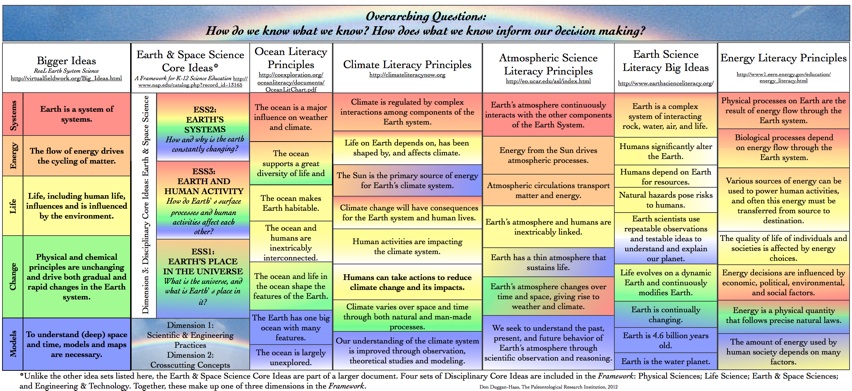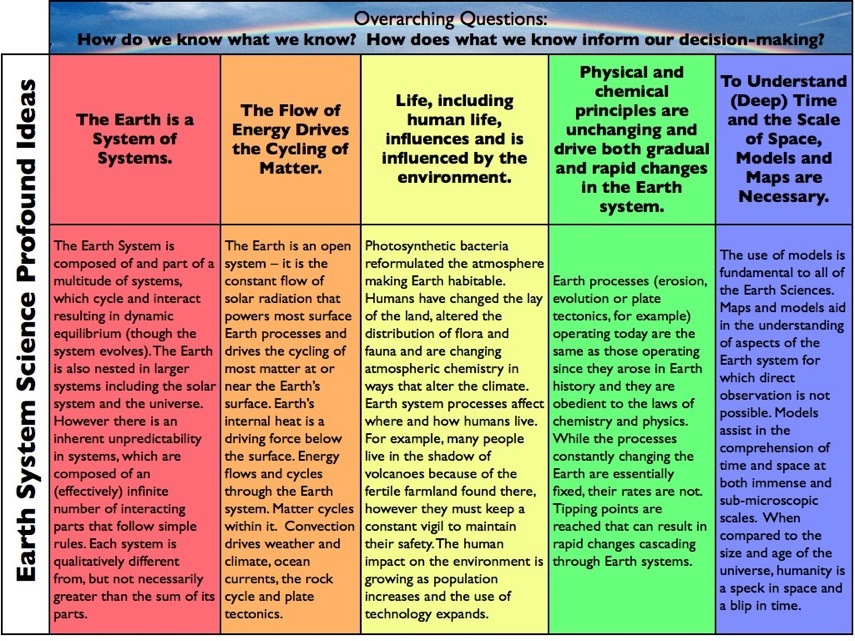Earth Systems Literacy Initiatives

OUtside Projects Related to Big Ideas
A series of National Science Foundation initiatives is defining essential principles or big ideas in Earth system science disciplines. It is intended by some that these initiatives will coalesce into an overarching set of principles for all of Earth system science.
This bulleted list includes links to each initiative and the corresponding sets of principles. Scroll down the page to see a mapping of these principles to Earth Science Big Ideas developed for use in our projects.
-
 The Fundamental Principles of Climate Literacy from the Climate Literacy Network received official recognition from 13 federal agencies in 2009.
The Fundamental Principles of Climate Literacy from the Climate Literacy Network received official recognition from 13 federal agencies in 2009. -
 The Earth Science Literacy Initiative has drafted nine Big Ideas essential for understanding the solid Earth.
The Earth Science Literacy Initiative has drafted nine Big Ideas essential for understanding the solid Earth. -
 The Ocean Literacy Network has completed a framework of seven Essential Principles.
The Ocean Literacy Network has completed a framework of seven Essential Principles. -
 The Atmospheric Literacy Framework includes seven Essential Principles.
The Atmospheric Literacy Framework includes seven Essential Principles. -
 The Energy Literacy Principles includes seven Essential Principles.
The Energy Literacy Principles includes seven Essential Principles. -
 The Framework for K-12 Science Education (upon which the Next Generation Science Standards were built) has three dimensions including Disciplinary Core Ideas (DCIs). There are three DCIs for Earth & Space Science.
The Framework for K-12 Science Education (upon which the Next Generation Science Standards were built) has three dimensions including Disciplinary Core Ideas (DCIs). There are three DCIs for Earth & Space Science.
Note that in all four of the above idea sets, essential principles are undergirded by supporting concepts. There are between two to thirteen for each principle. Together there are 31 essential principles and 198 supporting concepts. Of course, there is substantial overlap among the different idea sets.
Earth Science Big Ideas:
-
 The Earth is a System of Systems
The Earth is a System of Systems -
 The Flow of Energy Drives the Cycling of Matter
The Flow of Energy Drives the Cycling of Matter -
 Life, Including Human Life, Influences and is Influenced by the Environment.
Life, Including Human Life, Influences and is Influenced by the Environment. -
 Physical and chemical principles are unchanging and drive both gradual and rapid changes in the Earth system.
Physical and chemical principles are unchanging and drive both gradual and rapid changes in the Earth system. -
 To Understand (Deep) Time and the Scale of Space, Models and Maps are Necessary
To Understand (Deep) Time and the Scale of Space, Models and Maps are Necessary
The chart is color coded to indicate correlations between Essential Principles from the literacy initiatives to Big Ideas from our projects. White is used to show connection to the overarching questions. Other colors are shown in the column labeled “Bigger Ideas.”
The label is intended to draw attention to the idea that there are truly a great many big ideas and there is arguably a need for something “bigger than big.”










